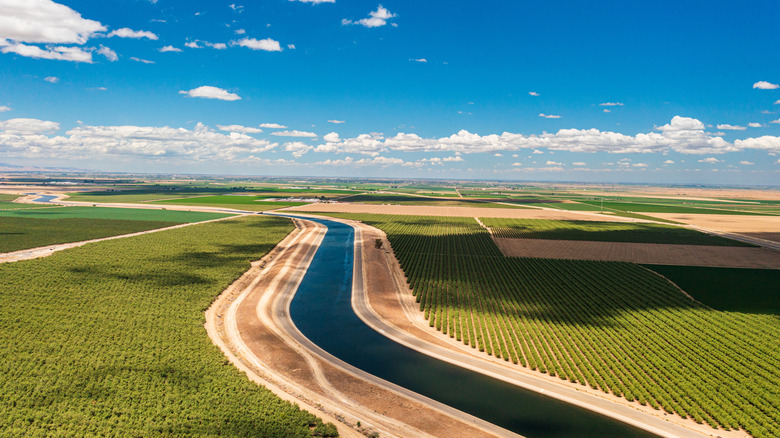Why California Grows More Crops Than Any Other State
They call California's Salinas Valley the "Salad Bowl of the World" — and with good reason. The region produces half of America's leafy greens and more than 70% of the nation's lettuce, including iceberg lettuce, which helped to change the way Americans eat. But that's a fraction of what the Golden State grows. Its Mediterranean climate — with hot, dry summers and mild, wet winters — creates ideal conditions for growing hundreds of different types of crops year-round.
You've probably seen the results at the grocery store: strawberries, grapes, oranges, almonds, and even white rice, a crop you wouldn't instinctively pair with California (Nishiki, Amazon's top-rated brand of dried white rice, according to consumer reviews, hails from Commerce). The state generates more than 400 different varieties of produce and leads the country in over 60 of them. That accounts for 1/3 of all U.S. vegetables and 2/3 of the country's fruits and nuts.
Nearly every region in California plays a role in the wide variety of what grows there. You've got wine grapes in the sunny Napa Valley, avocados in San Diego County, garlic in Gilroy, and rice in the Sacramento Valley. In the far south, the Imperial Valley grows melons and leafy greens year-round, thanks to water from the Colorado River. The state is a patchwork of microclimates and regional specialties, making its output uniquely diverse.
While much of the harvests stays in America, a large portion heads for its ports. In 2023, California exported $22.4 billion in agricultural goods to more than 150 countries. Even with just 4% of the nation's farms and ranches, it's by far America's top agricultural producer.
How did California agriculture become what it is today?
Well before the Gold Rush, California's land was used by Spanish settlers for small-scale farming and cattle grazing. It wasn't until the 1920s that agriculture started to look like the big business it is today. Developing technology was a huge part of the industry's growth. Refrigerated railcars like the Pacific Fruit Express were a common sight on the rails in the early 1900s. With tons of ice from the Rockies keeping them cool, the cars could carry leafy greens and veggies across the country, keeping them as fresh and ripe as the day they were picked by the time they hit the market.
The New Deal brought major changes to California's water system in the 1930s and boosted farming in the Central Valley, a 400-mile stretch that produces the majority of the state's crops. Massive federal infrastructure projects like the Central Valley Project helped store and transport water from Northern to Southern California, creating a reliable water supply that allowed farmers to grow year-round without relying on unpredictable rain. That water is why the area produces more almonds than anywhere else in the world, and why it's one of four state nuts (it's complicated).
With agriculture using about 40% of the state's water, innovation is key in the battle against drought. A growing ag-tech sector is focused on conserving water, farming more efficiently, and maximizing crop yields to get the most out of every acre, even in the desert. The future isn't just about growing more; it's about growing smarter.

